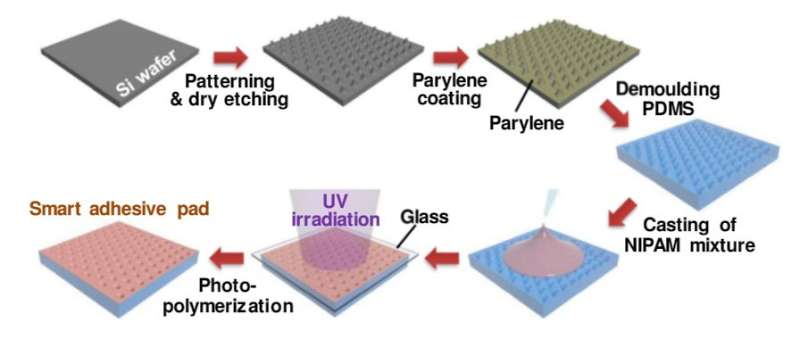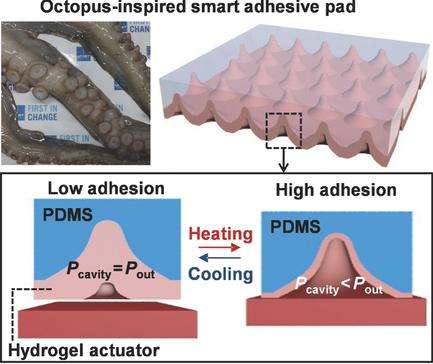July 6, 2016 report
Suction cup mat based on octopus's suckers developed to build flexible pressure sensors

(Phys.org)—A team of researchers working at South Korea's National Institute of Science and Technology has found a way to make building flexible pressure sensors easier—by mimicking the suction cups on octopus's tentacles. In their paper published in the journal Advanced Materials, the researchers describe how they studied the octopus's parts and then used what they learned to develop a new type of suction based adhesive material.
Building flexible sensors, the researchers note, is difficult and cumbersome—it requires moving nano- and/or microribbons of inorganic semiconductor materials onto rubber sheets. Making the process easier, the researchers thought, could be done by building a simple suction device that could hold onto the material and then let go without grabbing it. To build such a device, they turned to the octopus—it gets around, they noted by moving its tentacles to a new location and then holding on using suction cups. The suction cups work due to muscles around their edges that can be made thinner or thicker on demand, increasing or decreasing air pressure inside the cup, allowing for sucking and releasing as desired.
To mimic the octopus suction cups, the researchers created a small rubber mat made out of polydimethylsiloxane (a type of silicon that has a rubbery texture) with small pits on one side. At room temperature, the walls of each pit sit in an 'open' state, but when the mat is heated to approximately 32°C, the walls contract, creating suction, allowing the entire mate to adhere to a material. To use the mat as a device to move materials, all the team needed to do was heat it, apply to the material, move to the new location, then allow the mat to cool, whereupon the material would be dropped into place.
The team reports that the mat worked as envisioned—they made some indium gallium arsenide transistors that sat on a flexible substrate and also used it to move some nanomaterials to a different type of flexible material. They believe there might be a wide variety of applications that could benefit from such mats, such as Band-Aids or sensors that stick to the skin at normal body temperatures but fall off when rinsed under cold water.

More information: Hochan Lee et al. Octopus-Inspired Smart Adhesive Pads for Transfer Printing of Semiconducting Nanomembranes, Advanced Materials (2016). DOI: 10.1002/adma.201601407
Abstract
By mimicking muscle actuation to control cavity-pressure-induced adhesion of octopus suckers, smart adhesive pads are developed in which the thermoresponsive actuation of a hydrogel layer on elastomeric microcavity pads enables excellent switchable adhesion in response to a thermal stimulus (maximum adhesive strength: 94 kPa, adhesion switching ratio: ≈293 for temperature change between 22 and 61 °C).
Journal information: Advanced Materials
© 2016 Phys.org



















